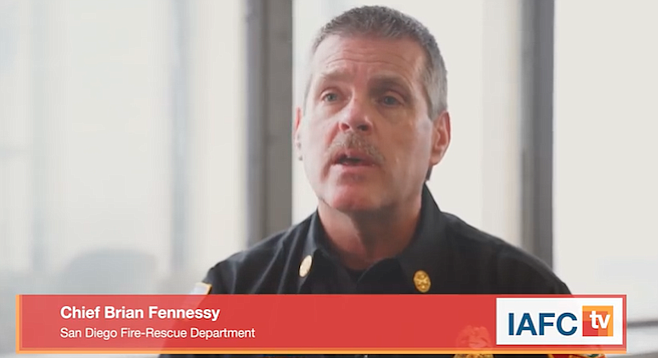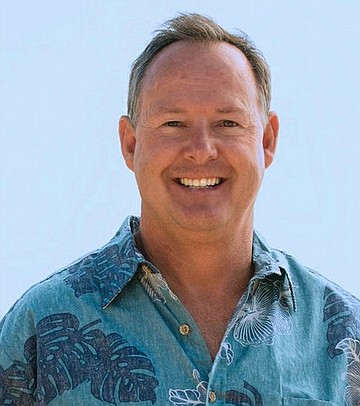 Facebook
Facebook
 X
X
 Instagram
Instagram
 TikTok
TikTok
 Youtube
Youtube

Eleven San Diego lifeguards, whose union rep Sgt. Ed Harris seemed to have embarrassed San Diego Fire and Rescue into allowing them to go to the flood zone after initially refusing to send them, were never deployed to Houston, Harris said on September 1st.

"They said they were going to fly us out through March Air Force Base but the orders were never signed," Harris said. "Our guys were staged and ready all day Wednesday and all day Thursday, and then Thursday night they were told to stand down."
On Saturday, August 26th, San Diego Fire and Rescue chief Brian Fennessy sent 35 rescue-trained firefighters and 10 drivers to Houston with a flotilla of boats and gear. The lifeguards had been ordered to give the firefighters their boats and gear because they weren't being deployed, which outraged them. When the lifeguards asked for permission to use their vacation time to go help on their own time, they were told that they would be disciplined for abandoning their San Diego jobs.
The Reader broke the story of the lifeguards being denied their request to go to Houston early Tuesday morning (August 29). By midday Tuesday, Fennessy was being called on to explain why rescuers whose specialty is water rescues, who routinely operate boats as part of the job, and who have special training in swift-water rescues were not being sent to the flooded Texas region.
By Wednesday night, the chief appeared to have either had either a change of heart or fresh orders, and he told the media the team was being sent. But, Harris says, they weren't.
"It got the media off their backs," Harris said. "That's all they wanted." While the lifeguards said that they were being prevented from doing what they do best, the chief and mayor Kevin Faulconer blasted them for what they described as politicizing decisions about how much help to send and who should go.
Harris agrees that the conflict between the lifeguard wing of fire and rescue and the policy decisions made by the chief goes deeper and longer than the current brawl over who goes to Houston. But, he said, the question in this situation comes down to two things: who has the training and gear, and the lifeguards' desire to help people in the midst of the worst U.S. flooding disaster since Hurricane Sandy.
Fennessy seemed more focused on command structure and the big picture. Command structure in fire departments — especially in mutual-aid situations — is critical in controlling and allocating resources, he explained in a written statement on September 1st: "Late today, representatives from the California Office of Emergency Services (CalOES) held a conference call with fire agency chief officers representing all of the CalOES designated and available swift water rescue teams, concerning an anticipated state-to-state Emergency Management Assistance Compact (EMAC) request to deploy to Texas. CalOES informed those on the conference call that they had not received, nor do they anticipate receiving an EMAC request from the State of Texas for more than two of the CalOES sponsored swiftwater rescue teams."
San Diego's swift-water team wasn't asked, he said. Then he went on to say that the fire department has actively participated in mutual aid, and that the chief retains the authority to approve or disapprove mutual-aid requests from other agencies.
"However, it is my sworn duty to NOT honor or approve any outside agency mutual aid request for resources if doing so would cause the department to unreasonably deplete its resources, facilities, and/or services which would then represent an unacceptable risk to the residents and visitors of the City of San Diego."
Harris says that, for his team, it's not about orders — it's a cultural difference between lifeguards and firefighters. "If we waited until we had backup to rescue people, they would die," Harris said. "No matter how many people are there, once you start to swim, you're alone. We accept that as part of the job. Our first thought is saving people, not waiting for protocols and conditions."
UPDATE Sunday, September 3, 12:15 p.m.
---------- Forwarded message ----------
From: Munoz, Monica
Date: Sat, Sep 2, 2017 at 11:20 PM
Subject: Your article re CalOES swift water rescue team
To: [Marty Graham]
Marty
Chief Fennessy reviewed your article and noted the inaccuracies. I have attached the article and our corrections.
I have also attached the email statement that I sent out on Wednesday, August 30 and the email I sent in response to your request for information on Sept. 1 at 4:53 p.m. You indicated your deadline was 6 p.m. and I answered you within about 20 minutes. You also left me a voice mail message on Sept. 1 at 4:55 p.m.
We would appreciate the online version of the article being corrected as soon as possible.
Thank you,
Mónica Muñoz
Media Services Manager
City of San Diego
SD Fire-Rescue / Communications Department


Eleven San Diego lifeguards, whose union rep Sgt. Ed Harris seemed to have embarrassed San Diego Fire and Rescue into allowing them to go to the flood zone after initially refusing to send them, were never deployed to Houston, Harris said on September 1st.

"They said they were going to fly us out through March Air Force Base but the orders were never signed," Harris said. "Our guys were staged and ready all day Wednesday and all day Thursday, and then Thursday night they were told to stand down."
On Saturday, August 26th, San Diego Fire and Rescue chief Brian Fennessy sent 35 rescue-trained firefighters and 10 drivers to Houston with a flotilla of boats and gear. The lifeguards had been ordered to give the firefighters their boats and gear because they weren't being deployed, which outraged them. When the lifeguards asked for permission to use their vacation time to go help on their own time, they were told that they would be disciplined for abandoning their San Diego jobs.
The Reader broke the story of the lifeguards being denied their request to go to Houston early Tuesday morning (August 29). By midday Tuesday, Fennessy was being called on to explain why rescuers whose specialty is water rescues, who routinely operate boats as part of the job, and who have special training in swift-water rescues were not being sent to the flooded Texas region.
By Wednesday night, the chief appeared to have either had either a change of heart or fresh orders, and he told the media the team was being sent. But, Harris says, they weren't.
"It got the media off their backs," Harris said. "That's all they wanted." While the lifeguards said that they were being prevented from doing what they do best, the chief and mayor Kevin Faulconer blasted them for what they described as politicizing decisions about how much help to send and who should go.
Harris agrees that the conflict between the lifeguard wing of fire and rescue and the policy decisions made by the chief goes deeper and longer than the current brawl over who goes to Houston. But, he said, the question in this situation comes down to two things: who has the training and gear, and the lifeguards' desire to help people in the midst of the worst U.S. flooding disaster since Hurricane Sandy.
Fennessy seemed more focused on command structure and the big picture. Command structure in fire departments — especially in mutual-aid situations — is critical in controlling and allocating resources, he explained in a written statement on September 1st: "Late today, representatives from the California Office of Emergency Services (CalOES) held a conference call with fire agency chief officers representing all of the CalOES designated and available swift water rescue teams, concerning an anticipated state-to-state Emergency Management Assistance Compact (EMAC) request to deploy to Texas. CalOES informed those on the conference call that they had not received, nor do they anticipate receiving an EMAC request from the State of Texas for more than two of the CalOES sponsored swiftwater rescue teams."
San Diego's swift-water team wasn't asked, he said. Then he went on to say that the fire department has actively participated in mutual aid, and that the chief retains the authority to approve or disapprove mutual-aid requests from other agencies.
"However, it is my sworn duty to NOT honor or approve any outside agency mutual aid request for resources if doing so would cause the department to unreasonably deplete its resources, facilities, and/or services which would then represent an unacceptable risk to the residents and visitors of the City of San Diego."
Harris says that, for his team, it's not about orders — it's a cultural difference between lifeguards and firefighters. "If we waited until we had backup to rescue people, they would die," Harris said. "No matter how many people are there, once you start to swim, you're alone. We accept that as part of the job. Our first thought is saving people, not waiting for protocols and conditions."
UPDATE Sunday, September 3, 12:15 p.m.
---------- Forwarded message ----------
From: Munoz, Monica
Date: Sat, Sep 2, 2017 at 11:20 PM
Subject: Your article re CalOES swift water rescue team
To: [Marty Graham]
Marty
Chief Fennessy reviewed your article and noted the inaccuracies. I have attached the article and our corrections.
I have also attached the email statement that I sent out on Wednesday, August 30 and the email I sent in response to your request for information on Sept. 1 at 4:53 p.m. You indicated your deadline was 6 p.m. and I answered you within about 20 minutes. You also left me a voice mail message on Sept. 1 at 4:55 p.m.
We would appreciate the online version of the article being corrected as soon as possible.
Thank you,
Mónica Muñoz
Media Services Manager
City of San Diego
SD Fire-Rescue / Communications Department
Comments